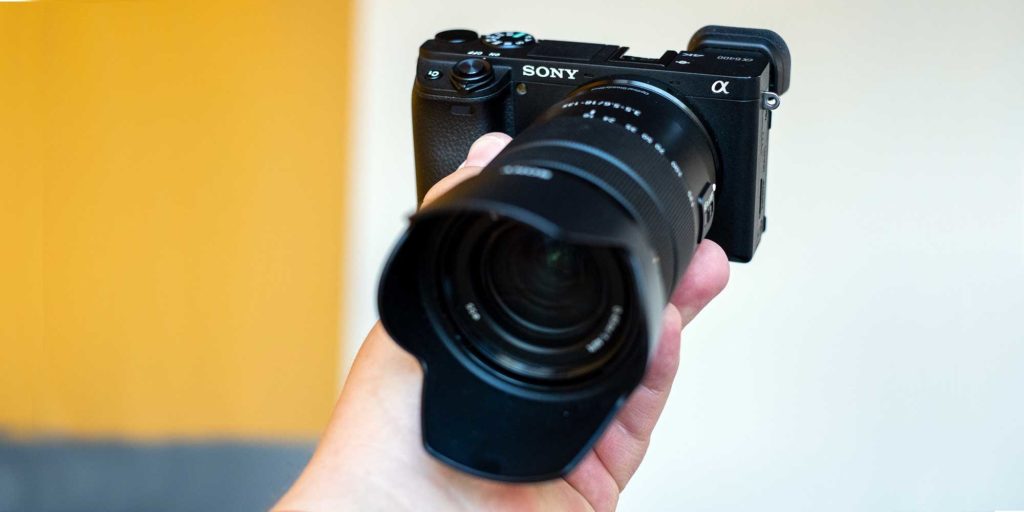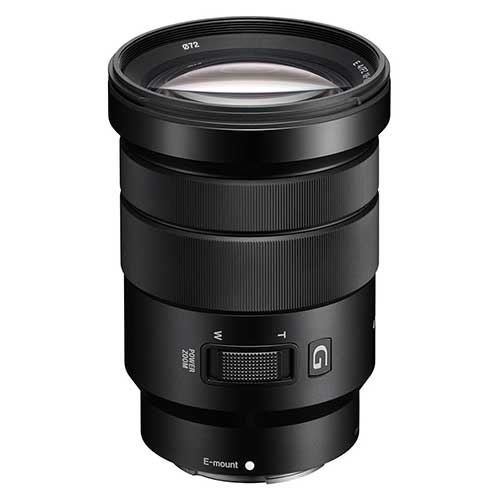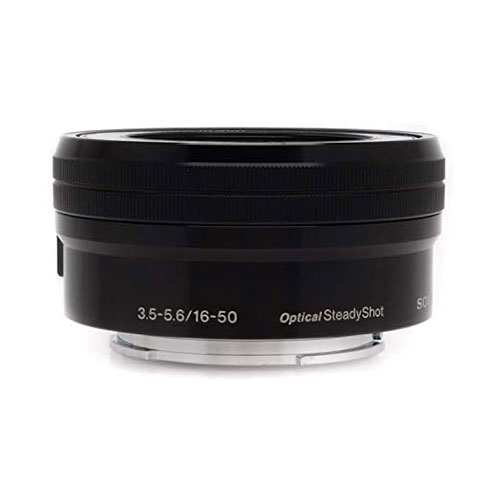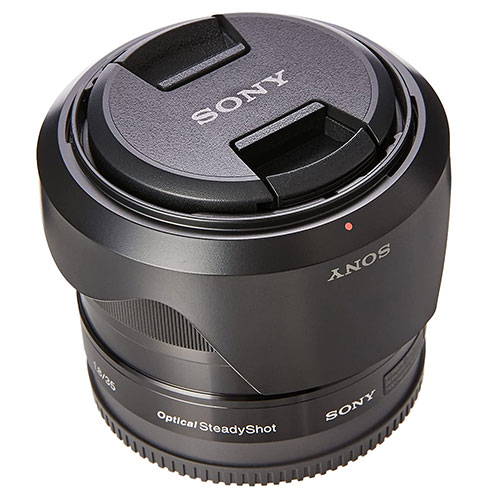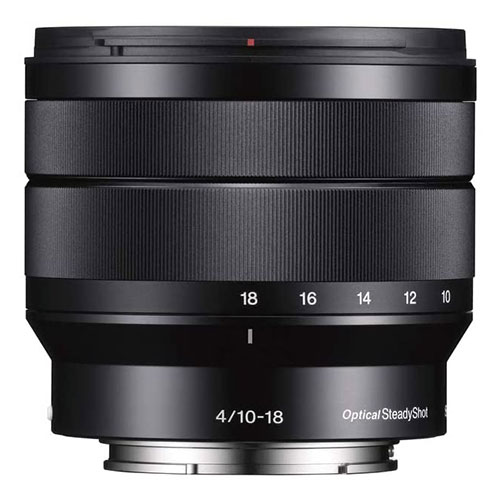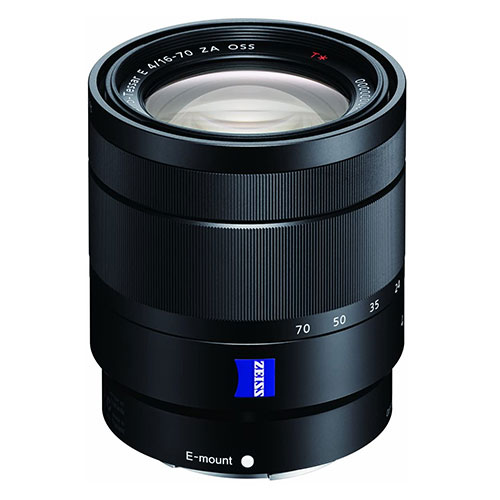Combining an array of pro-level features in a small APS-C package, Sony’s Alpha 6400 is an excellent camera for vloggers and videographers looking for a take-anywhere solution for “run-and-gun” movie making.
The fact that the camera also comes with 4K video, excellent AF tracking, and an articulating touchscreen only serve to underline the fact that Sony clearly had vloggers and budget film makers specifically in mind when designing the a6400.
However, while the a6400’s moviemaking credentials are not in doubt, sadly Sony has yet to provide a6400 users with a truly convincing range of native video-oriented lenses.
And while many of the brand’s impressive full-frame glass is theoretically compatible with the a6400, most of these lenses cannot be used without a compromise in performance that renders them much less suitable for video work.
What’s a poor a6400 user to do?
Fear not, I’ve sifted though Sony’s APS-C E-mount lens lineup and picked out the most qualified candidates for the job.
In the end of this article, I’ve also put together an in-depth guide outlining all the most important features that you should be on the lookout for when choosing a video lens to use with your Sony a6400.
Sony E PZ 18-105mm f/4 G OSS
Looking for a single lens for the a6400 that will let you shoot pretty much everything a vlogger or videographer might ever need to shoot? Look no further.
True, not only is the E PZ 18-105mm f/4 G OSS something of a mouthful, but it’s also a biggie by Mirrorless standards.
But then again, carrying all the individual primes needed to cover the focal lengths offered by this zoom – equivalent to 27-158mm on full frame – would take up much more room in your bag. For many a6400 users this will be a major selling point.
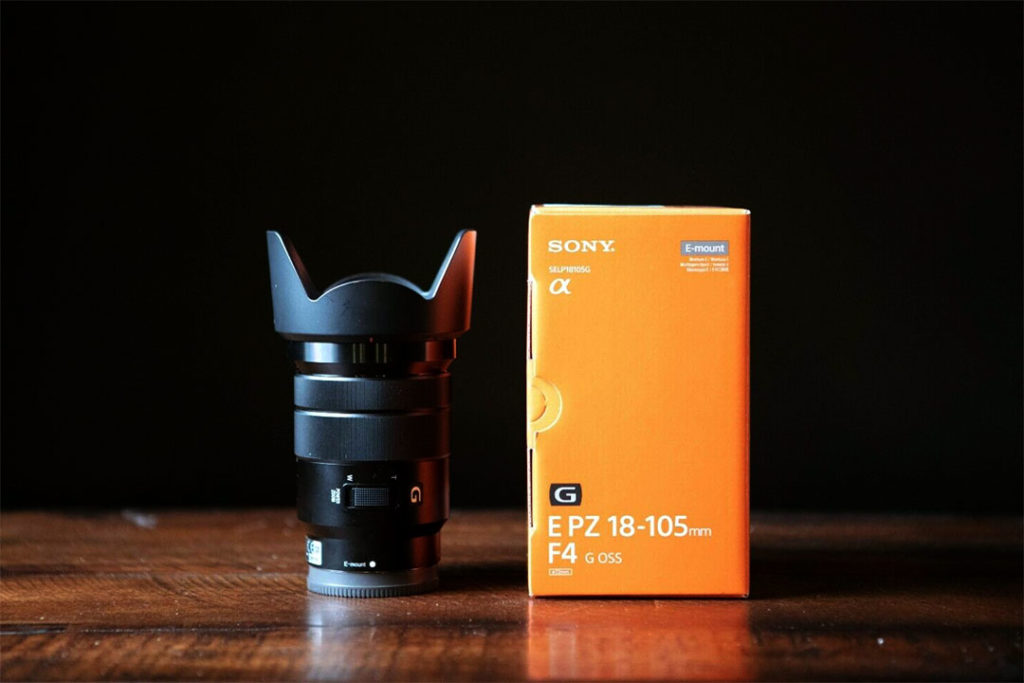
What’s more, the build of this lens feels very solid and metallic. Yet despite this, it’s not excessively heavy. Another win for hard-working videographers.
Although the maximum aperture of f/4 isn’t especially fast, this setting is at least constant throughout the zoom range.
Meaning that the lens is particularly well-suited to video work where you might want to zoom in without the image getting darker as you do so.
Videographers will also be pleased to learn that the lens exhibits no focus breathing either. So focus-racks won’t lead to accidental changes to your framing.
But in case you do want to zoom while you’re filming, there’s a handy superzoom function offering three different speeds. Much smoother than trying to do it manually by turning the ring.
Let’s turn our attention to image quality now.
Using the lens at the 18mm setting, there is great center sharpness and contrast at f/4, but with noticeably softer corners. Shut down just a stop, though, and the corners also start looking pretty impressive. Not a bad performance at all.
And at longer zoom settings the story is pretty similar. Although if anything the center of the image is even sharper now. Nice work!
Less positively, the lens displays some noticeable distortion, even at the widest zoom settings. And this only gets worse as you approach the longer end of its reach.
Also, while bokeh is perfectly acceptable, personally I think that it lacks any real charm. And some subjects can end up looking a little busy when defocussed.
Over all, though, I would say that the lens offers a pretty good performance in terms of optics. Although you will need to keep in-camera corrections switched on when filming in order to avoid distortion issues.
Autofocus also works well, and the AF motor is silent. Which of course is another point in favor of this lens if you’re considering it for video use.
What’s more, OSS is extremely effective, turning even the shakiest of footage into smooth and stable clips.
As far as vloggers and videographers are concerned, then, the news just gets better and better.
In fact, the only real downside I can find to this lens is the fact that it’s not weather sealed. Whether that’s a deal-breaker for you, though, is something you’ll have to decide for yourself.
But because the 18-105mm f/4 combines an amazing zoom range, short minimum focus distance, with solid image quality, a relatively fast maximum aperture, good AF, and highly effective OSS, I figure that the majority of videomakers will find this lens a real pleasure to work with.
Especially vloggers. Hence why it takes the top spot in this guide to the best a6400 lenses for video and vlogging.
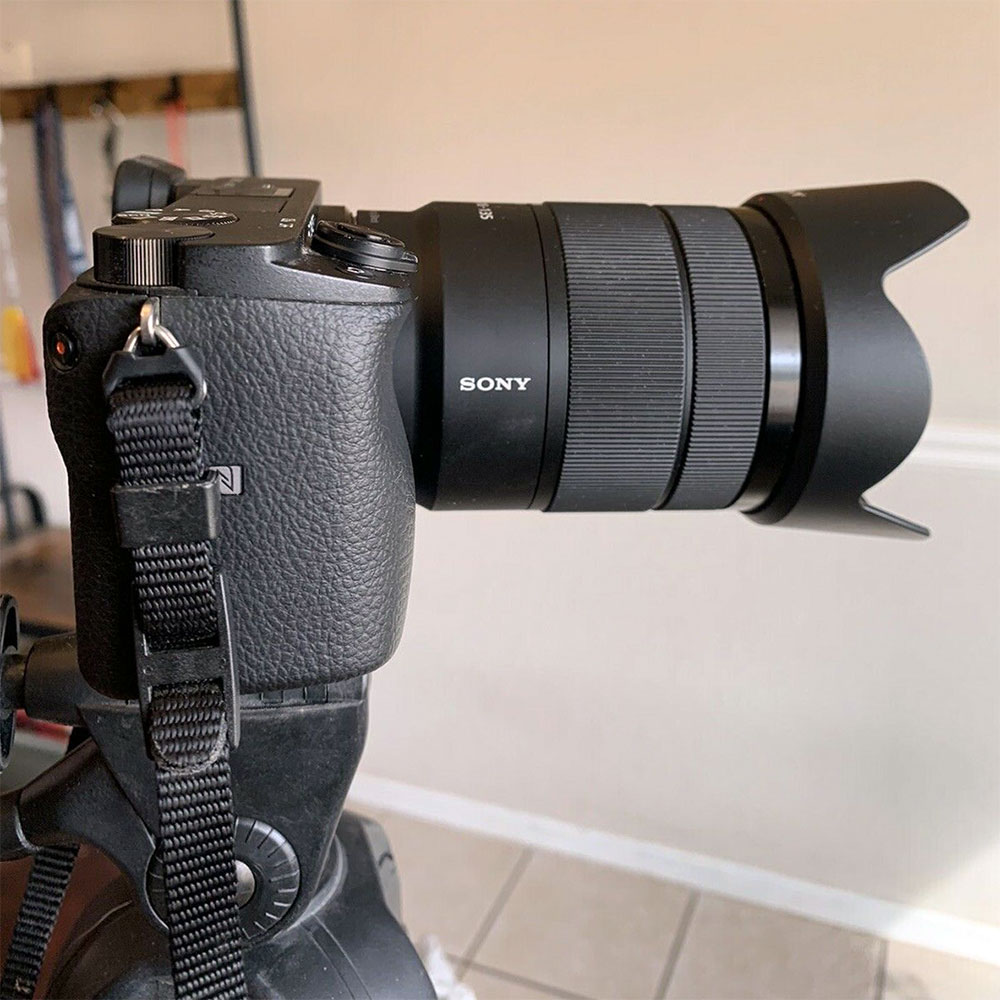
Having said this, those looking for a less vlog-focussed option – and willing to put down some serious money in order to get it – would also do well to consider my next recommendation, as it is effectively a much more advanced version of this lens.
Sony E PZ 18-110mm F4 G OSS
If you’re more interested in the art and craft of movie making than in shooting rough and ready video diaries, you may want to invert the top two listings in this guide, as this lens is almost certainly going to be the better option for you.
Indeed, Sony pitches the E PZ 18-110mm f/4 G OSS as a dedicated cine-zoom, and it certainly produces some amazing results when used to shoot 4K.

To be clear though, this piece of glass is in a totally different league to the 18-105mm lens (above). And this fact is very clearly reflected in the price. It’s by no means cheap!
You also get something of an idea of what kind of beast you’re dealing with merely from looking at the 18-110mm f/4; it is absolutely enormous!
And while many film makers swear by using this thing with smaller cameras such as the a6400, they clearly aren’t a well balanced match. So you’ll need to take extra care not to let the whole thing nose-dive at the first opportunity.
Despite it’s size, though, this is actually a great lens for fast-paced documentary work. Allowing as it does for quick changes in focal length, and handheld shooting in relatively low light.
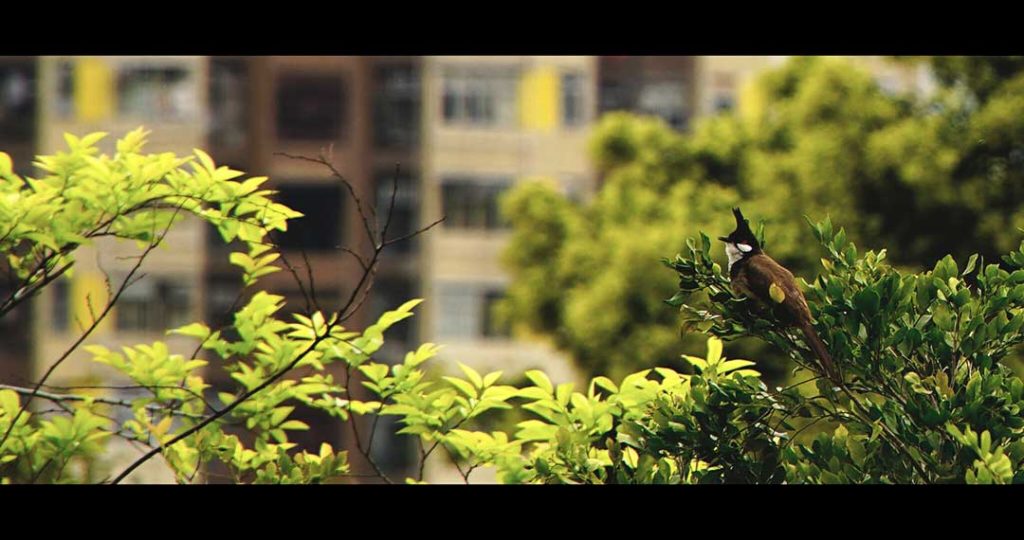
And let’s be clear, with a zoom range that is equivalent to 27-165mm on full-frame, you certainly get plenty of different focal lengths to choose from, from wide angle to telephoto lens.
Importantly, though, the lens’s maximum aperture of f/4 remains constant throughout the zoom range. So not only is there no compromise in light-gathering abilities at longer focal lengths, but you can also zoom while filming without causing any changes to exposure.
And it must be said that zooming is a real pleasure here.
In addition to a regular motorized zoom ring with reversible zoom direction, there is also a power-zoom function for automated zooming, plus a true manual zoom mode that bypasses the motors altogether for when more dramatic manual action is needed.
What’s more, autofocus works brilliantly and very smoothly. It also remains totally silent, so you could easily get away with using a camera-mounted mic if required.
And for advanced film makers the addition of pitched gears adds to the lens’s abilities to work with external focus accessories
Admittedly the optical image stabilization is perhaps not the best out there. But it nonetheless does its job pretty well.
Footage produced using this lens is invariably beautifully crisp and contrasty. However, as with the 18-105mm f/4 (above) there’s some quite noticeable distortion, particularly at wider zoom settings. And vignetting is also fairly dominant.
The answer, of course, is simply to keep Sony’s in-camera corrections turned on while filming, and let technology take care of these issues for you.
All things considered, then, this is a fantastic pro-level videographer’s lens that will likely appeal to many serious film makers with a good budget to spend. That being the case, though, it would be total overkill for the average vlogger.
Sony E PZ 16-50mm f/3.5-5.6 OSS
Let me start this by being totally clear; the Sony E PZ 16-50mm f/3.5-5.6 OSS is simply the kit lens that comes packaged with many of the brand’s APS-C cameras, including some a6400 bundle deals.
As it happens, though, it’s also one of the best lenses for vlogging currently available from Sony. So to leave it off my list would be highly misleading.
And if you already own it, and were considering making a more video-centric upgrade, well, you may save yourself some money by reading this.
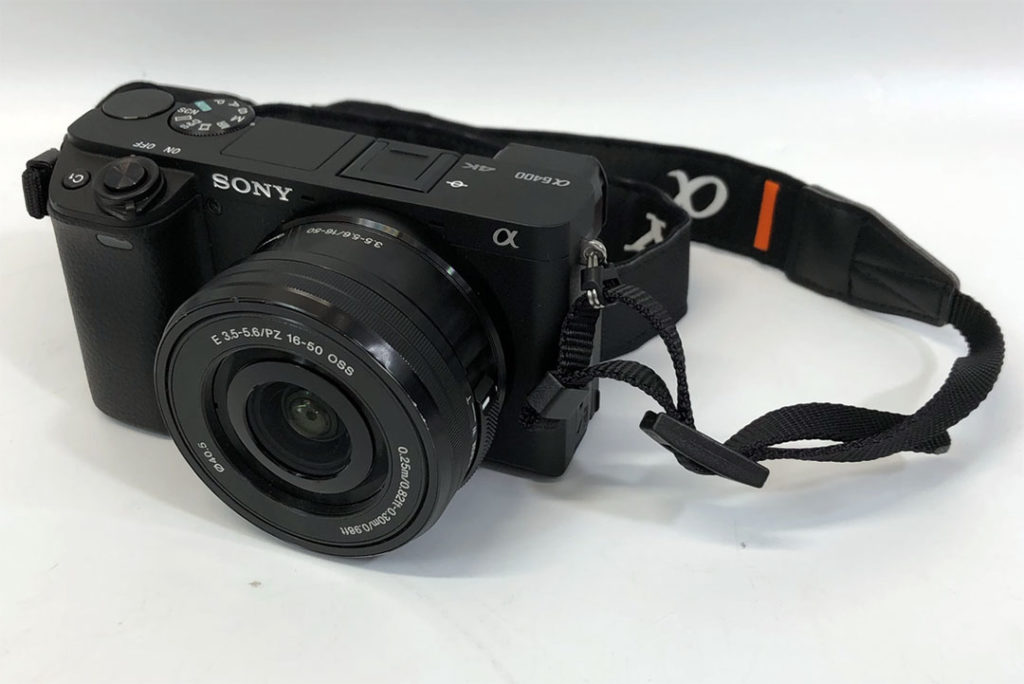
For vloggers and videographers who want to travel light, the primary draw of this lens is that it combines a surprisingly long zoom range in an absolutely tiny little package; while also managing a relatively fast maximum aperture and very decent image quality.
That’s a lot more than even many of Sony’s much more expensive products can manage.
Admittedly maximum aperture drops from f/3.5 to f/5.6 as you work your way through the zoom range. But this still puts it ahead of most alternative Sony cropped-format zooms, which typically can’t manage more than f/4 at any focal length.
Also, despite its “basic” tag, the16-50mm f/3.5-5.6 OSS actually comes with a power-zoom feature. Sure, it’s only single-speed; not quite at the same level as on Sony’s more expensive offerings.
But the inclusion of this function is nonetheless very welcome.
Another draw here is that the fast and accurate autofocus motor is pretty much silent, making the lens well suited to video work using the a6400’s internal mics.
Similarly, optical image stabilization works very well; only further sealing this lens’s videography credentials.
Finally, the lens boasts surprisingly solid optics – better even than some much more expensive lenses. Indeed, at the widest zoom and aperture settings, center sharpness is very impressive.
Although, as I’ve come to expect from Sony by now, the corners are somewhat less impressive looking when used wide open. Close down a stop or two, however, and sharpness and contrast are excellent all round.
What’s more, at longer zoom settings things are actually much better in the corners. And even the already-impressive central sharpness improves a little too. Good stuff!
In short, this lens actually compares very favorably to the top performers in this guide. Even outdoing some of Sony’s much more expensive glass.
You might want to hang onto your kit lens after all!
Sony E 35mm f/1.8 OSS
Compact, lightweight, and very solidly built, Sony’s E 35mm f/1.8 OSS is an honest little prime lens that many videographers will will want to carry with them at all times.
True, it’s probably not wide enough for the average vlogger; offering the full-frame equivalent of roughly a 50mm angle of view, the E 35mm f/1.8 OSS essentially what constitutes a “standard” lens in a6400-land.
It is, however, a very useful lens for any videomakers who do not spend most of their days shooting wide angle selfies. Not only useful for the versatile focal length, though, but also because it comes with an extremely fast (for Sony) maximum aperture, and the added bonus of optical image stabilization.
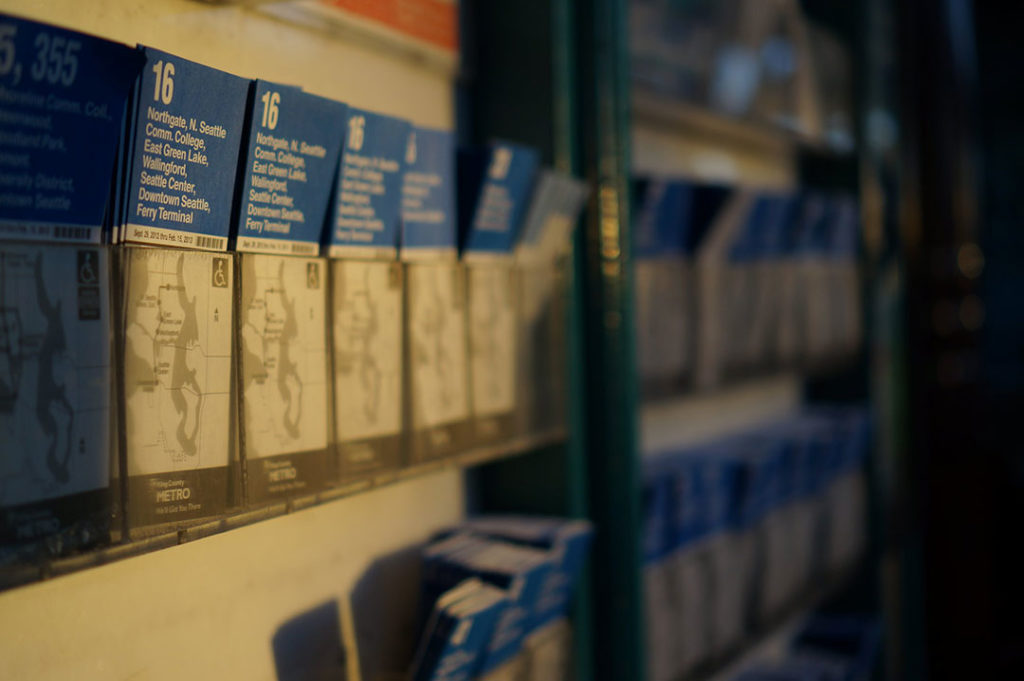
Although it must be said that while the OIS is definitely good to have, it’s perhaps not the best performing lens in Sony’s lineup on this front.
OIS is, however, totally silent. As is autofocus. Thus firmly establishing this lens’s credentials for video.
Although be aware that AF, too, is not among Sony’s fastest. Again, it works fine; but there are snappier performers out there.
Image quality is also plenty good enough for most purposes, yet rarely outstanding. Yes, even at f/1.8 you’ll see great center sharpness. However, at this aperture the corners are a little soft and, there’s a noticeable degree of color fringing too.
Shut the diaphragm down even slightly, though, and the corners resolve nicely and any color fringing quickly clears up. So image quality is by no means bad.
Less seriously, there’s noticeable vignetting at the widest aperture.
But this also vanishes at smaller f/stops. And of course, by keeping in-camera corrections turned on, you’ll avoid this issue entirely anyway.
So far so good-ish.
And in keeping with the acceptable – but far from exceptional – performance we’ve seen in all other areas with this lens, Bokeh is also fairly attractive. But again, nothing to write home about.
All things considered, then, the 35mm f/1.8 is a good, but not outstanding, piece of glass. It certainly won’t let you down. But nor does it come with much in the way of unique features, character, nor charm.
For most videographers and vloggers, however, this kind of workaday, neutral, lens will be absolutely fine.
True, the 35mm f/1.8 is not exactly cheap. But nor is it outrageously expensive.
All in all, there’s little here to complain about. But equally few features to get excited over either.
However, if you’re looking for a Sony prime lens for everyday videography with the a6400 – one that offers a winning combination of a fast maximum aperture and optical image stabilization – then this is undoubtedly it.
In the sense that there’s currently no other comparable native option available.
Sony E 10-18mm f/4 OSS
Offering an angle of view equivalent to a 15-27mm lens on a full frame camera, while remaining extremely compact and lightweight, Sony’s E 10-18mm f/4 OSS wide angle zoom lens is perhaps the ultimate a6400 lens for vlogging – just as long as you can live with its limitations.
We’ll get to those in a minute. For now though, let’s consider the lens’s main advantages, beyond its super-useful wide ange zoom range.
For a start, the 10-18mm f/4 is simply very well built; constructed as it is from sturdy engineered plastics and featuring a metal lens mount.
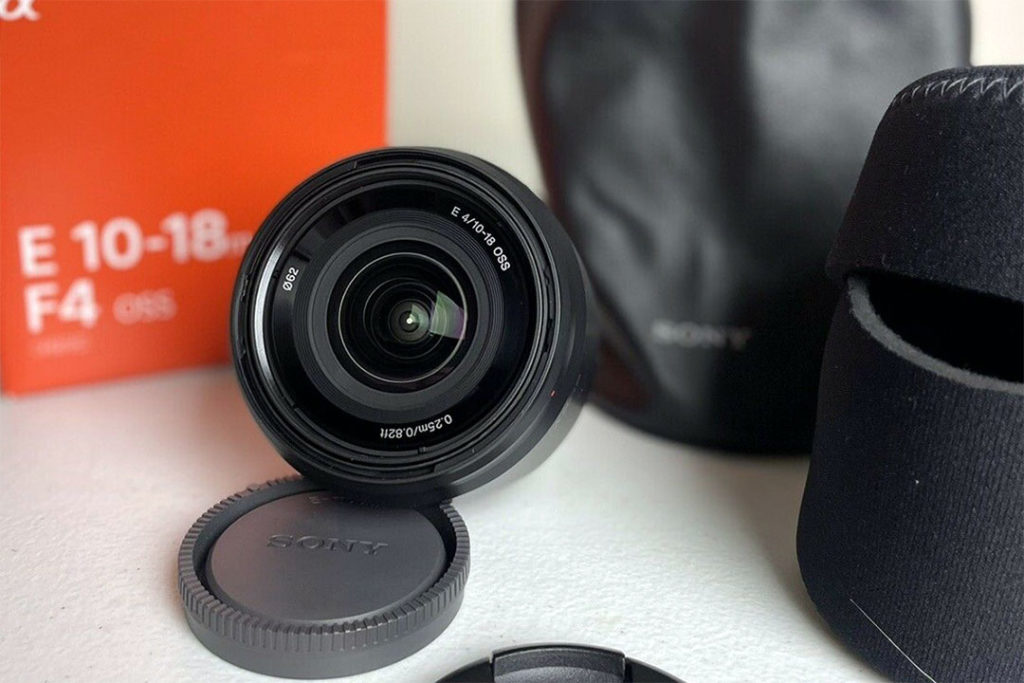
Then there’s the inclusion of optical image stabilization. While OIS becomes less essential the wider a lens gets – and this lens is extremely wide – it can still be very useful for video work, making for much smoother handheld sequences.
So the fact that Sony added SteadyShot here is to me a clear sign that they had vloggers and videographers specifically in mind when they designed this wide angle zoom lens.
Autofocus is overall fairly fast and accurate, but it should be noted that it doesn’t always hit the mark in trickier shooting situations (such as with backlit subjects or in low light).
Meanwhile a grippy focus ring provides nicely damped manual action that will satisfy all but the most demanding of videographers.
So far that’s not a bad performance at all.

Unfortunately, though, the real issues begin when we turn our attention to image quality.
To be clear, it’s not all bad news; at the 10mm zoom setting, and shooting wide open at f/4, center sharpness is actually excellent. While edge resolution lags a little behind. Stop down to f/5.6, though, and even the corners improve dramatically.
Where the story becomes a little less joyous is when shooting at f/4 at longer zoom settings; here not even center sharpness is all that impressive.
Again though, stopping down improves things significantly. But it does mean that if you care about image quality, you will probably want to avoid using this lens at maximum aperture when shooting towards the 18mm mark.
For some videographers this restriction will make little difference to how they work; for others it will be intolerable.
Finally, while neither distortion nor chromatic aberration are of any great concern with this lens, there is considerable vignetting at all zoom settings.
And this issue is still detectable to a degree even after stopping down. However, this is of course a problem that is fairly easy to fix by means of software, so it certainly isn’t worth worrying about to the same degree as image sharpness.
Finally, while f/4 will be plenty fast enough for most videographers and vloggers – particularly those who use artificial lighting – many a6400 users may prefer to go for something a little faster.
To summarize, then, I wouldn’t hesitate to recommend this lens to the average vlogger – who may be more interested in versatility (replacing several prime wide angle lenses) and convenience than sharpness and contrast.
However, I would encourage more artfully-inclined videomakers to consider carefully whether they can live with the limitations in image quality and aperture that inflict this lens.
Sony Vario-Tessar T* E 16-70mm f/4 ZA OSS
Offering a full-frame equivalent focal length of 24-105mm, on paper the Sony E 16-70mm f/4 ZA OSS looks like a very handy lens for videography with the a6400.
And it certainly can be, as long as you don’t mind living with a degree of compromise. Let’s take a closer look.
The first thing that you’ll likely notice about this lens is its solid, metal build. Yet at the same time it’s very compact and lightweight.
Although be aware that, despite its slim profile, the front element extends quite far out when zoomed.
Not that this is generally a problem in everyday use of course.
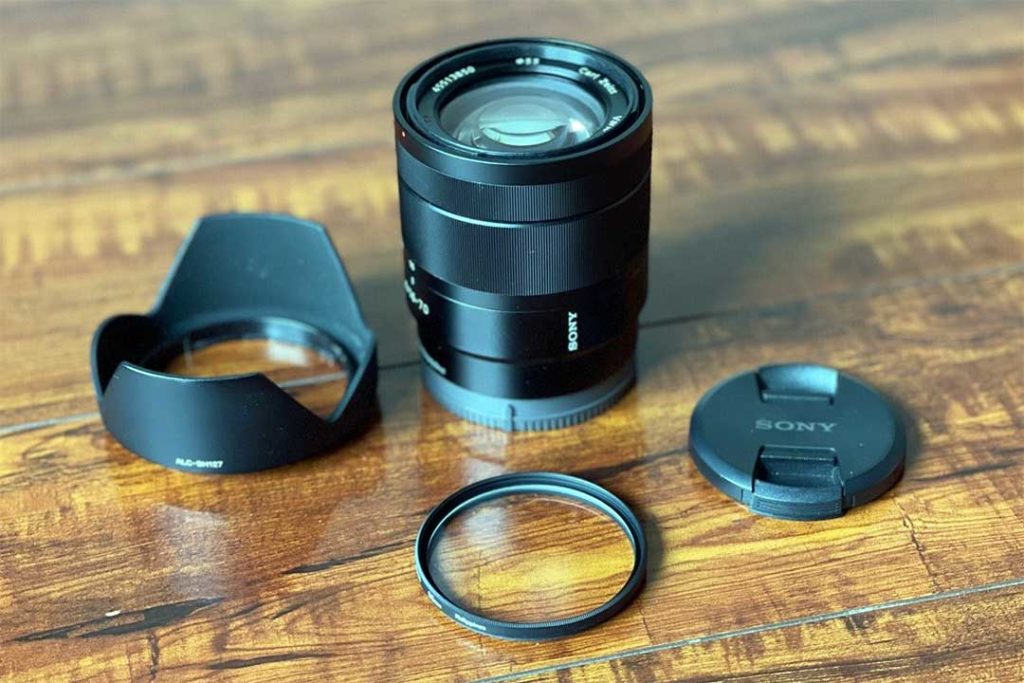
The lens features good image stabilization. True, it’s perhaps not the best that money can buy, but it’s still pretty impressive.
And the same goes for autofocus, which is plenty fast and accurate, but not necessarily state of the art.
So far, then, this lens delivers a fairly solid – if somewhat unexciting – performance.
However, as with 10-18mm f/4 lens (above), the more serious problems only really start once we turn our attention to image quality.
Yes, at the 16mm position and shooting at f/4, we can see excellent sharpness and contrast at the center of the frame – so there’s certainly nothing to worry about here.
Unfortunately, however, images become much softer the closer we get to the corners. And there’s even some color fringing here, too. As you might expect though, stopping down even slightly will massively improve corner resolution.
At mid zoom settings, things continue in a similar vein, with far better performance at the center than at the edges when using the widest aperture. Although the corners get much better by about f/8.
The real issue occurs at the longest zoom settings, where image quality is actually not very good at all at f/4 – neither in corners nor at the center!
Yes, things do improve at smaller aperture settings. But still, this is quite a disappointing optical performance at the longer end of the zoom range.
And unfortunately the situation doesn’t get much better when we look at issues like distortion and vignetting either, with both quite apparent when using the lens with in-camera corrections turned off.
Of course, these latter issues are much easier to rectify than is a basic lack of optical precision. But given that image sharpness already gives some cause for concern, these extra optical flaws only add to the somewhat unimpressive overall specs.
Bokeh is a more positive affair, however. True, you won’t get much in the way of soft bokeh when using a wide angle lens on an APS-C camera. But it is possible to throw backgrounds out of focus. And when you do, the bokeh is perfectly attractive.
Nothing incredible, mind. Nonetheless, I don’t find the results to be overly busy or distracting. So there’s at least that.
That’s all very well, but by now you might be asking, if image quality is so poor, why am I even recommending this lens to a6400 users? Well, firstly, not all vloggers need excellent image quality. Or even if they do, they might be fine with only getting it at wider zoom settings – where they are likely to spend most of their time anyway.
In any case, many users may value the other features that this lens has to offer over its optical abilities.
But there’s also another important issue; there just aren’t that many lenses in the current Sony lineup that are both fully compatible with the a6400 body and well-suited to video work.
Given the lack of choice, then, it would seem unwise to rule out a lens which is otherwise highly appropriate for the task of videomaking.
With that said, I’m clearly not going to give this lens a wholehearted recommendation. Which is why it’s sitting right down here at the bottom of the list.
Nonetheless, as long as you are aware of the lens’s optical limitations, and are happy to live with them, the E 16-70mm F4 still could be a good option for some vloggers and videographers.
Don’t say I didn’t warn you though!
What to Look for When Choosing Sony a6400 Lenses for Vloggers & Film Makers
Maximum Aperture

The wider a lens’s aperture will go, the more light will hit the camera’s sensor. This offers the primary advantage of permitting you to shoot at a lower ISO for better resolution footage.
But a wide aperture will also help to create a more shallow depth-of-field. And this, too, is an important consideration for users of APS-C cameras such as the Sony a6400, where the smaller-than-full-frame sensor generally makes it harder to achieve out of focus backgrounds.
This being the case, as an a6400 videographer with an interest in producing cinematic images, you will likely want to purchase the fastest glass you can afford.
Unfortunately, though, many of the lenses in Sony’s cropped format E-mount range come with disappointingly slow maximum apertures. Indeed, where other brands and formats tend to manage f/2.8 almost as standard, here you’re lucky if you can find a decent zoom that goes beyond f/4.
Sony SteadyShot Optical Image Stabilization
While there’s a huge range of native Sony glass available to a6400 users, many of these lenses are not in fact 100% compatible with the camera. What this means in practice – in most cases at least – is that the lens will work just fine with the a6400 in every way except one: SteadyShot.
For some a6400 owners this will not be an enormous setback. But for those who are primarily interested in shooting video, on the other hand, the inability to make use of Sony’s usually excellent optical image stabilization is likely to be a total deal-breaker.
When it comes to vlogging and videography, OIS is pretty much indispensable. I mean, you’re unlikely to be able to shoot smooth and stable handheld footage without it – particularly when using slightly longer lenses.
Of course, it can be tempting to think that SteadyShot isn’t necessary at wider focal lengths. And it’s certainly true that camera shake will be a lot less noticeable when using shorter lenses. Nonetheless image stabilization still makes a real difference here. So unless you’re deliberately going for that action-movie style “shaky-cam” look, OIS is still the way to go even when using wide angles.
For this reason I recommend narrowing your search down to solely those lenses that are fully compatible with the a6400, so as to be able to benefit from Sony’s state of the art SteadySHot image stabilization technology.
As it happens, though, in this guide I’ve chosen to review only those Sony lenses that meet this important criteria. So you can rest assured that, if you decide to purchase any of the products I recommend here, your video clips should be smooth and professional looking every time.
One thing you will want to look out for, however, is that the IOS system doesn’t create any audible noise. As if it does, you will effectively be restricted to filming using only external off-camera mics.
Bokeh
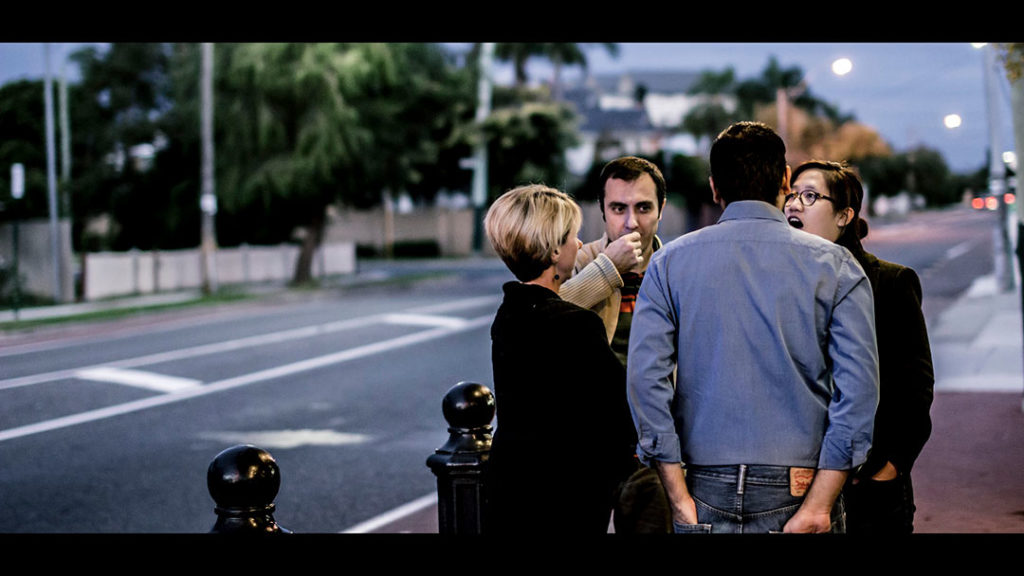
If you’re unfamiliar with the word bokeh – a Japanese import to the English language – if effectively translates as “blur,” but is commonly used to refer to the quality of out of focus areas of a photographic image. I.e. it doesn’t so much indicate how defocussed these areas are, but the way the blur looks.
For example, is it soft and smooth, or busy and distracting?
As just mentioned though, achieving extremely out of focus backgrounds can be a bit of a challenge on an APS-C sensor camera. It’s by no means impossible though – especially when using a longer lens – so if the quality of your backgrounds is important to you, be sure to check out the bokeh abilities of any lens you are considering purchasing.
The bokeh that a given lens produces depends upon a number of different factors. Ones that can’t really be understood simply by looking at a spec sheet.
In any case bokeh is a rather subjective matter. So the best way to understand whether a given lens produces “good” bokeh or not is simply to try it out. If you like the results, then you’re good to go.
Focusing
For vloggers and documentary videographers, fast and accurate autofocus is an absolute must. You won’t have time to waste with manual focusing your shots. And should you miss your mark, repeating the action is unlikely to be practical most of the time.
Here focus tracking can be a real life lifesaver. As can face and eye recognition technologies.
For those working at a more leisurely pace, however, manual focus will often be the method of choice, as it allows much greater creative control over the final results. Indeed, some impressive focus-pulling effects can only be achieved by manual means.
Unfortunately for this latter variety of film maker, most lenses produced specifically for modern Mirrorless camera systems don’t offer true manual focusing. Instead they come with a simulated version of manual control.
So when you turn what appears to be the lens’s manual focus ring – thinking that you are moving internal mechanical lens parts with your direct force – what’s actually happening is that the autofocus motors are moving the lens elements for you, via an electronic signal that first passes through the camera.
Unsurprisingly, this somewhat convoluted method of adjusting focus can sometimes lead to a degree of lag between your input and the lens’s reaction. Many videographers find this sensation highly unsatisfactory.
Other “by wire” lenses of this kind function much better, though, offering a reactive simulation of manual control that can be adjusted quite precisely.
Finally, one other important matter to mention when considering the focusing of lenses for video is motor noise. As with optical image stabilization, AF motors can sometimes produce an audible whirring or even grinding noise.
And if you plan on using you camera’s built-in microphone, this can totally ruin a take. So be sure to also check out motor noise before purchasing a lens.
Sharpness
Most lenses on the market today will be sharp in the center of the frame, especially when used at slightly smaller apertures than their maximum setting. So if you find a lens that can’t manage a nicely crisp and contrasty image at any aperture, there’s probably something seriously wrong with it and it should be sent back to the manufacturers.
Where differences in sharpness between lenses become more critical, then, is at wider apertures, and towards the edges of the frame.
Simply put, an optically excellent lens is one that produces images that are sharp from corner to corner, even at its widest aperture setting.
A good lens will produce images that are sharp in the center, but a little less so at the edges when used wide open; and then these problems will clear up as the lens is stopped down slightly.
Meanwhile, a just about acceptable lens is one that manages to produce images that are sharp at the center at most aperture settings, but still struggles at the edges even once stopped down.
And a total dud is that rare lens that can’t even manage a sharp and contrasty image at f/8.
Unfortunately you’ll find examples of almost all of these kinds of lenses among the products I recommend above. Normally I wouldn’t even bother reviewing lenses that fall into the third and fourth categories. But as the choice of video-oriented glass for the Sony a6400 is already somewhat limited, I don’t feel like we can totally reject these as options.
Primes vs Zooms
In most lens guides I use this section to weigh up the respective advantages and disadvantages of primes vs zooms. Typically I’ll characterize these differences just so: primes are often sharper and faster than zooms; whereas zooms will offer greater convenience, only at a price.
The reason I’ve only skimmed over the issue this time, though, is simply because, as a Sony a6400 user looking ooking for a lens for vlogging or videography, you are probably going to end up with a zoom whether you like it or not.
This is because there simply aren’t many prime lenses available for the a6400. At least not unless you are willing to forego optical image stabilization. And if you’ve read the SteadyShot section above, you’ll already know why I don’t consider that to be a good idea when it comes to shooting video.
Final Thoughts
The Sony a6400 is a great little camera that is very well suited to video work. And especially for vloggling. But unfortunately the same cannot be said for many of the lenses available for the a6400. Largely due to the issue of SteadyShot compatibility.
As we’ve seen though, thankfully some good videography options are available if you search carefully for them among Sony’s lens lineup. And if you’ve read through my guide to the best Sony a6400 lenses for videography and vlogging, you’ll now know precisely which ones they are.
But which lenses would you recommend for shooting video with the a6400? Do you disagree with any of my choices? Which Sony glass would you choose? I’d love to hear from you in the comments below!

